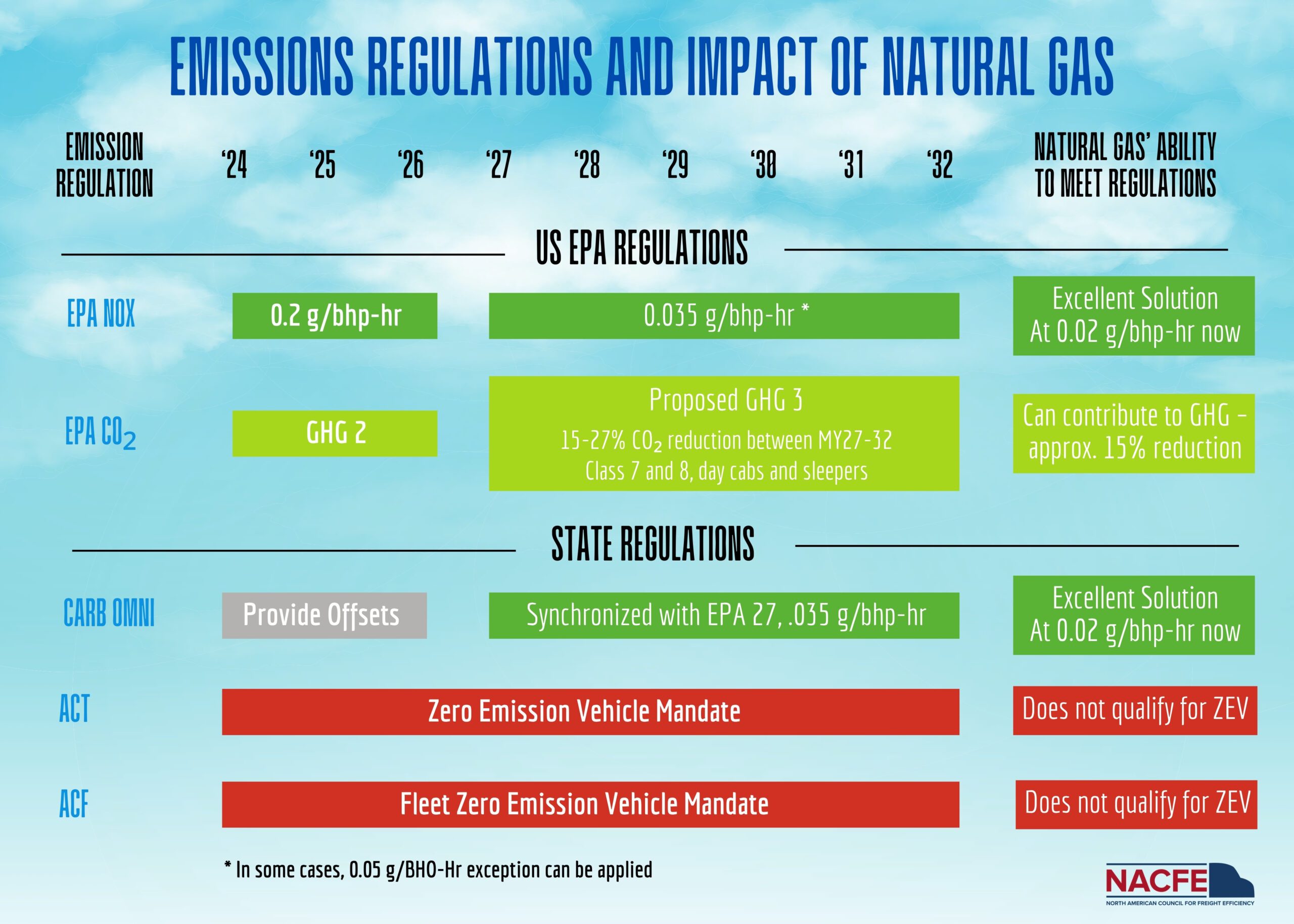Natural Gas, Battery-Electric Vehicles and the Long-Term Future – ACT News
Natural Gas, Battery-Electric Vehicles and the Long-Term Future - ACT News Advanced Clean Tech (ACT) News


The Role of Natural Gas in Decarbonizing Trucking

The trucking industry is currently in a phase where fleets have a range of powertrain options available to them. One such option is natural gas, particularly renewable natural gas. A recent report by the North American Council for Freight Efficiency (NACFE), titled “Natural Gas’ Role In Decarbonizing Trucking,” explores the place of natural gas in the trucking industry and discusses the opportunities and challenges that fleets may encounter if they choose to adopt natural gas as a fuel.
Benefits and Suitability of Natural Gas
While battery-electric vehicles (BEVs) are suitable for certain use cases such as terminal tractors, vans, step vans, medium-duty box trucks, and short regional haul Class 8 tractors, they are not yet suitable for all duty cycles. Natural gas, on the other hand, has the potential to reduce total greenhouse gas emissions and benefits from existing fueling infrastructure. This makes it well-suited for long return-to-base, regional haul, and long-haul disparate routes where BEVs are currently not a viable option.
However, it is important to note that compressed natural gas (CNG) engines have lower efficiency in terms of miles per diesel equivalent, and there may not be incentives available for their purchase.
New Developments in Natural Gas Engines
An interesting development in the natural gas sector is the introduction of the X15N fuel-agnostic 15-liter engine by Cummins. Fleets are hopeful that this engine will address some of the concerns associated with smaller natural gas engines currently available in the market.
Growth of Renewable Natural Gas
Natural gas has been used in combustion engines for many years, but fleets are now showing renewed interest due to its lower carbon emissions and cleaner burning properties. Additionally, the production capacity for renewable natural gas (RNG) has significantly increased, with RNG accounting for 69% of the natural gas used in transportation in 2022.
Challenges of Natural Gas as a Transportation Fuel
Despite its benefits, natural gas as a transportation fuel is not without challenges. These challenges revolve around issues such as methane leakage, tank cost and complexity, and the need to modify maintenance facilities to safely accommodate natural gas vehicles.
Considerations for Fleets
Fleets considering the adoption of natural gas trucks need to carefully evaluate the cost of adding these vehicles and the payback timeline. It typically takes five to 10 years for fleets to see a return on their investment in natural gas vehicles and the necessary infrastructure for fueling them.
Given the current state of the trucking industry and the position of BEVs on the technology adoption curve, it is likely that significant improvements in BEVs will occur within the five to 10-year payback period for natural gas trucks. Technologies at the early stages of adoption, like BEVs, often experience rapid advancements in a relatively short timeframe. We have already witnessed some of these improvements in BEVs, and further progress can be expected, especially with government mandates supporting BEV deployment and addressing concerns regarding charging infrastructure.
Fleets that invest in natural gas vehicles today may not have the budget to transition to the improved BEVs of the future, which are likely to feature lighter batteries and extended range. These improvements will expand the applications and use cases for BEVs, making them more appealing to fleets, particularly considering the incentives and grants available to offset the purchase price of these trucks.
In the midst of this complex landscape, fleets should take a long-term perspective when considering the integration of alternative-fueled vehicles into their operations. It is crucial to choose an option that makes sense in the short term while also positioning the fleet well for the future.
SDGs, Targets, and Indicators
| SDGs | Targets | Indicators |
|---|---|---|
| SDG 7: Affordable and Clean Energy | 7.3 By 2030, double the global rate of improvement in energy efficiency | No specific indicators mentioned in the article |
| SDG 9: Industry, Innovation, and Infrastructure | 9.4 By 2030, upgrade infrastructure and retrofit industries to make them sustainable | No specific indicators mentioned in the article |
| SDG 11: Sustainable Cities and Communities | 11.6 By 2030, reduce the adverse per capita environmental impact of cities, including by paying special attention to air quality and municipal and other waste management | No specific indicators mentioned in the article |
| SDG 13: Climate Action | 13.1 Strengthen resilience and adaptive capacity to climate-related hazards and natural disasters in all countries | No specific indicators mentioned in the article |
| SDG 15: Life on Land | 15.2 By 2020, promote the implementation of sustainable management of all types of forests, halt deforestation, restore degraded forests, and substantially increase afforestation and reforestation globally | No specific indicators mentioned in the article |
1. Which SDGs are addressed or connected to the issues highlighted in the article?
- SDG 7: Affordable and Clean Energy
- SDG 9: Industry, Innovation, and Infrastructure
- SDG 11: Sustainable Cities and Communities
- SDG 13: Climate Action
- SDG 15: Life on Land
The issues discussed in the article are connected to these SDGs because they involve the use of natural gas as a renewable and lower carbon fuel for trucks, which contributes to affordable and clean energy (SDG 7). The adoption of natural gas trucks also relates to industry innovation and infrastructure (SDG 9), as fleets need to consider the cost, infrastructure, and maintenance facilities required for natural gas vehicles. Additionally, the article mentions the reduction of greenhouse gas emissions and the potential for renewable natural gas, which aligns with climate action (SDG 13) and sustainable management of forests (SDG 15). The impact on cities and communities (SDG 11) is also mentioned in terms of reducing environmental impacts and improving air quality.
2. What specific targets under those SDGs can be identified based on the article’s content?
- Target 7.3: By 2030, double the global rate of improvement in energy efficiency
- Target 9.4: By 2030, upgrade infrastructure and retrofit industries to make them sustainable
- Target 11.6: By 2030, reduce the adverse per capita environmental impact of cities, including by paying special attention to air quality and municipal and other waste management
- Target 13.1: Strengthen resilience and adaptive capacity to climate-related hazards and natural disasters in all countries
- Target 15.2: By 2020, promote the implementation of sustainable management of all types of forests, halt deforestation, restore degraded forests, and substantially increase afforestation and reforestation globally
The article does not explicitly mention these targets, but the adoption of natural gas trucks can contribute to improving energy efficiency (Target 7.3) by reducing greenhouse gas emissions compared to diesel trucks. Upgrading infrastructure for natural gas fueling stations and modifying maintenance facilities for natural gas vehicles can also contribute to sustainable industry practices (Target 9.4). The use of natural gas as a lower carbon fuel can help reduce the adverse environmental impact of transportation on cities (Target 11.6) by improving air quality and reducing emissions. Additionally, the adoption of renewable natural gas can contribute to climate resilience (Target 13.1) by reducing overall greenhouse gas emissions. While the article does not directly address forests, the promotion of sustainable management practices and the use of renewable natural gas can indirectly support efforts to halt deforestation and restore degraded forests (Target 15.2).
3. Are there any indicators mentioned or implied in the article that can be used to measure progress towards the identified targets?
No specific indicators are mentioned or implied in the article that can be used to measure progress towards the identified targets.
Behold! This splendid article springs forth from the wellspring of knowledge, shaped by a wondrous proprietary AI technology that delved into a vast ocean of data, illuminating the path towards the Sustainable Development Goals. Remember that all rights are reserved by SDG Investors LLC, empowering us to champion progress together.
Source: act-news.com

Join us, as fellow seekers of change, on a transformative journey at https://sdgtalks.ai/welcome, where you can become a member and actively contribute to shaping a brighter future.







